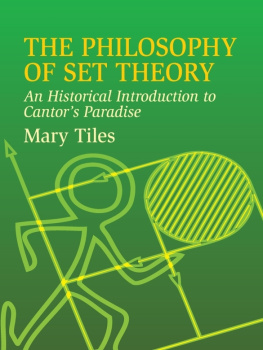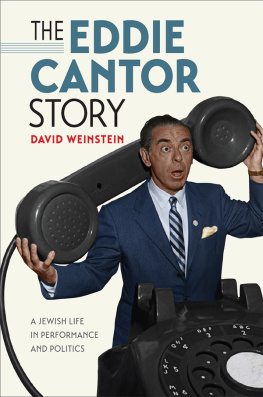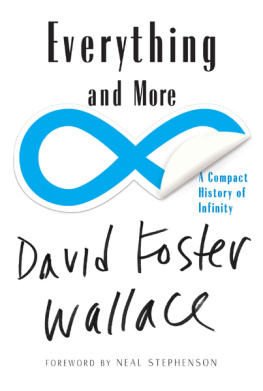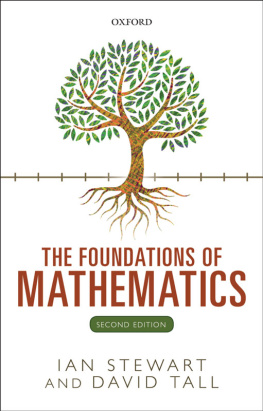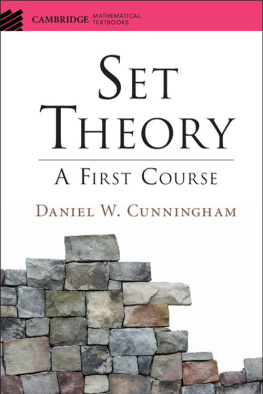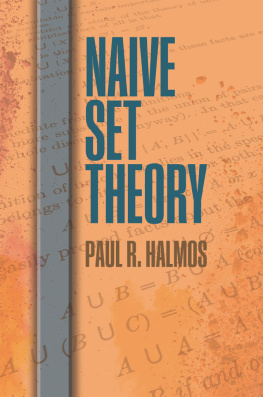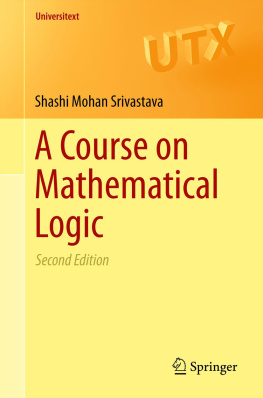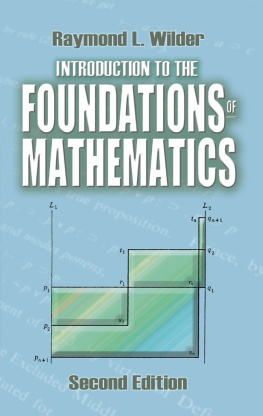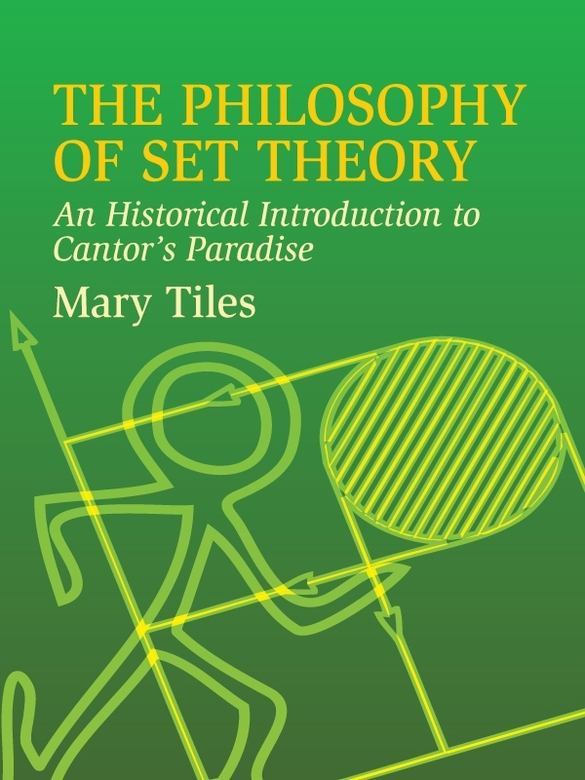Bibliography
Aristotle (1984) J. Barnes (ed.) The Complete Works of Aristotle , Princeton University Press/Bollingen Series LXXI 2, Princeton.
Bell, J. L. (1977) Boolean Valued Models and Independence Results in Set Theory , Oxford University Press, Oxford.
Benacerraf, P. and Putman, H. (ed.) (1964) Philosophy of Mathematics : Selected Readings (1st edn), Prentice-Hall, Englewood Cliffs, NJ.
Benacerraf, P. and Putnam, H. (ed.) (1983) Philosophy of Mathematics : Selected Readings (2nd edn), Cambridge University Press, Cambridge.
Berkeley, G. (1734) The analyst or a discourse addressed to an infidel mathematician. Reprinted in The Works of George Berkeley , A. A. Luce and T. E. Jessop (eds) Thomas Nelson and Sons Ltd. (1948 51).
Bernoulli, Jakob (Jaques) (1713) Ars Conjectandi, Basle, pt. IV, ch. 5. English translation of pt. IV by Bing Sung, Harvard University Dept. of Statistics Technical Report 2 (1966).
Bishop, E. (1967) Foundations of Constructive Analysis, McGraw-Hill, New York.
Bolzano, B. (1851). Paradoxien des Unendlichen, Leipzig, tr. as Paradoxes of the Infinite, F. Prihonsky, Routledge and Kegan Paul, London; Yale University Press, New Haven (1950).
Boolos, G. (1971). The iterative conception of set. Journal of Philosophy, 68; reprinted in Benacerraf & Putnam (1983).
Bostock, D. (1975) Logic and Arithmetic Vol. 2, Clarendon Press, Oxford.
Boyer, C. B. (1959) The History of the Calculus and its Conceptual Development, Dover, New York.
Brouwer, L.E.J. (1949) Consciousness, philosophy and mathematics. Proceedings of the Tenth International Congress of Philosophy (Amsterdam , 1948) vol. 1., Pt. 2, E. W: Beth, H. J. Pos and J. H. A. Hollack (eds), Amsterdam (1952). Reprinted in Benacerraf and Putnam (1964, 1983).
Cantor, G. (1883) Fondaments dune thorie gnrale des ensembles Acta Mathematica 2, 381 408.
(1915/1955) Contributions to the Founding of the Theory of Transfinite Numbers, tr. P. E. B. Jourdain, Open Court, LaSalle, Illinois/ Dover, New York.
Carruccio, E. (1964) Mathematics and Logic in History and Contemporary Thought , Faber and Faber, London.
Chihara, C. (1973) Ontology and the Vicious Circle Principle , Cornell University Press, Ithaca, NY.
Cohen, P. J. (1966) Set Theory and the Continuum Hypothesis , W. A. Benjamin, New York.
Dantzig, T. (1954) Number: The Language of Science , Allen and Unwin, London.
Dauben. J. W. (1979) Georg Cantor: His Mathematics and Philosophy of the Infinite , Harvard University Press, Cambridge, Massachusetts.
Dedekind, R. (1901/1963) Essays on the Theory of Numbers . Tr. W. W. Beman, Open Court, Chicago/Dover, New York.
Drake, F. R. (1974) Set Theory: An Introduction to Large Cardinals , North Holland, Amsterdam.
Dummett, M. (1959) Wittgensteins philosophy of mathematics. Philosophical Review , LXVIII, 324 48. Reprinted in P. Benacerraf and H. Putnam (1964).
(1963) Realismin Dummett (1978).
(1967) entry on Frege in P. Edwards (ed.) The Encyclopedia of Philosophy , Free Press, MacMillan, New York. Reprinted as Freges philosophy in Dummett (1978).
(1978) Truth and Other Enigmas, Duckworth, London.
Einstein, A. (1920) The Theory of Relativity , tr. R. W. Lawson, Methuen, London.
Feyerabend, P. (1975) Against Method, NLB, London.
Fitting, M. (1969) Intuitionistic Logic, Model Theory and Forcing, North Holland, Amsterdam.
Fraassen, B. C. van (1970) An Introduction to the Philosophy of Space and Time , Random House, New York.
Frege, G. (1959) The Foundations of Arithmetic , tr. J. L. Austin, Basil Blackwell, Oxford.
Gale, R. (1967) The Philosophy of Time , Anchor Books, New York.
Geach, P. T. (1962) Reference and Generality, Cornell University Press, Ithaca, New York.
Gdel, K. (1938) The consistency of the axiom of choice and the generalized continuum hypothesis. Proc. Nat. Acad. Sci. USA , 24, 556 7.
(1939) Consistency proof for the generalized continuum hypothesis. Proc. Nat. Acad. Sci. USA, 25, 220 4.
(1944/1964) Russells mathematical logic. In P.A. Schilpp (ed.) The Philosophy of Bertrand Russell, The Library of Living Philosophers. Tudor Pub. Co., New York. Reprinted in P. Benacerraf and H. Putnam (1964, 1983).
(1947) What is Cantors continuum problem? Am. Math. Monthly , 54, 515 25. Reprinted in P. Benacerraf and H. Putnam (1964, 1983).
Goodman, N. (1964) A world of individuals. In P. Benacerraf and H. Putnam (1964).
Grant, E. (1969) Medieval and seventeenth-century conceptions of the extracosmic void Isis, 60, p. 41 60.
Hacking, I. (1965) The Logic of Statistical Inference, Cambridge University Press, Cambridge.
(1975) The Emergence of Probability, Cambridge University Press, Cambridge.
Hallett, M. F. (1979) Towards a theory of mathematical research programmes I and II British Journal for the Philosophy of Science, 30, pp. 1 25, 135 59.
(1984) Cantorian Set Theory and the Limitation of Size , Clarendon Press, Oxford.
Hatcher, W. S. (1968) Foundations of Mathematics , W. B. Saunders Co., Philadelphia.
Hausdorff, F. (1957) Set Theory , tr. J. R. Aumann et al ., Chelsea Publishing Co., New York.
Heijenhoort, J. van (ed.) (1967) From Frege to Gdel , Harvard University Press, Cambridge, Massachusetts.
Hilbert, D. (1925) On the infinite. In J. van Heijenhoort (1967).
Hobbes, T. (1665) De Corpore , pt. I, ch. 2. English translation in I. C. Hungerland and G. R. Vick (eds) Thomas Hobbes Part I of De Corpore tr. A. Martinich, Abaris Books, New York (1981).
Hofstadter, D. R. (1979) Gdel, Escher, Bach: an eternal golden braid , Basic Books, New York.
Jech, T. (1978) Set Theory , Academic Press, New York.
Kleene, S. C. (1967) Introduction to Metamathematics , North Holland, Amsterdam.
Kneale, W. (1949) Probability and Induction, Clarendon Press, Oxford.
Kneale, W. and Kneale M. (1962) The Development of Logic , Clarendon Press, Oxford.
Kuhn, T. (1962) The Structure of Scientific Revolutions , University of Chicago Press, Chicago.
Lakatos, I. (1963) Proofs and refutations. British Journal for Philosophy of Science , 1 25, 120 39, 221 43, 296 342.
Leibniz, G. (1702) Letter to Varignon, with a note on the Justification of the Infinitesimal Calculus by that of Ordinary Algebra pp. 542 6. In Leibniz Philosophical Papers and Letters tr. L. E. Loemker (ed.) Reidel, Dordrecht (1969).
(1966) Logical Papers, tr. G. H. R. Parkinson (ed.) Clarendon Press, Oxford.
Levy, A. and Solovay, R. M. (1967) Measurable cardinals and the continuum hypothesis. Israel Journal of Mathematics , 5, pp. 234 48.
Lucas J. R. (1973) A Treatise on Time and Space , Methuen, London.
Long, A. A. and Sedley, D. N. (1987) The Hellenistic Philosophers , Vol. 1, Cambridge University Press, Cambridge.
Lucas, J. R. (1973) A Treatise on Time and Space , Methuen, London.
Lusin, N. (1917) Sur la classification de M. Baire. Comptes Rendus de lAcadmie des Sciences de Paris , 164, pp. 91 4.
(1925) Sur les ensembles projectifs de M. Henri Lebesgue Comptes Rendus de lAcademie des Sciences de Paris , 180, pp. 1572 4.
Maddy, P. (1984) New directions in the philosophy of mathematics. Philosophy of Science Association , 2, 427 48.
Mannheim, J. H. (1964) The Genesis of Point Set Topology , Pergamon, London.
Mansfield, R. and Weitkamp, G. (1985) Recursive Aspects of Descriptive Set Theory , Oxford University Press, Oxford.
McGuire J. E. (1983) Space, geometrical objects and infinity: Newton and Descartes on extension. In W. R. Shea (ed.) (1983).

